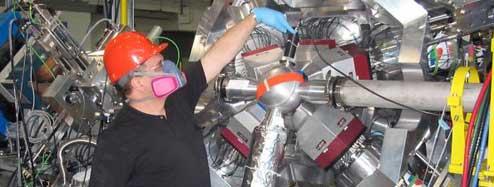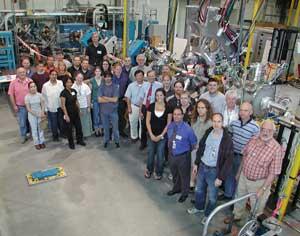
In the first experiment with the TRIUMF-ISAC Gamma-Ray Escape Suppressed Spectrometer (TIGRESS) at its home in ISAC-II, a team of scientists from TRIUMF, Lawrence Livermore National Laboratory (LLNL), University of Guelph and 12 other international institutions measured the electromagnetic excitation probability for the neutron-rich unstable nucleus 29Na. The results of this experiment will illuminate the inner workings of exotic nuclei, which is itself crucial to our understanding of how stars evolve, explode, and create the matter that we see around us.
Atoms of 29Na were produced, ionized, and accelerated to approximately 7% the speed of light at ISAC. The delivery of 29Na radioactive ion beam (RIB) taxed the accelerator systems to their limits. To inject the ions to the accelerators, the RIB extraction voltage had to be set at 99% of its absolute design limit – the highest voltage ever used during an experiment. In addition to 29Na, the RIB source produces almost 200 times as much 29Al (aluminum-29), and excessive 29Al in the beam delivered to TIGRESS could have compromised the experiment. The ISAC beam delivery staff overcame these challenges and, in their first attempt, delivered up to 600 29Na ions per second.
These particles were steered to the TIGRESS experimental station, where the BAMBINO particle detector system was also installed. TIGRESS, a next-generation array of high energy-resolution, position-sensitive gamma-ray spectrometers, was built by a team of scientists from TRIUMF and Canadian universities (led by University of Guelph) for a wide range of experiments in nuclear and fundamental science. The BAMBINO silicon detector, electronics and target foil were provided by LLNL, while the vacuum chamber was built at University of Rochester. Scientists from LLNL led this particular experiment.
The 29Na beam particles hit the target foil, which was 97.6% pure 110Pd (palladium-110). The electrical repulsion between palladium and sodium was strong enough that even with the 29Na traveling at 7% the speed of light, the two nuclei could not touch. In near-miss, almost head-on collisions, the repulsion was violent enough that there was a small probability that it left either the 29Na or 110Pd nucleus in an excited state – much like if a bus swerves to avoid hitting a dump truck, the passengers might spill their coffees on one another. However, these near-misses were rare; 999 out of every 1000 29Na particles passed through the 110Pd foil without incident.
The excited nuclei then relaxed by emitting gamma rays; about one-quarter of these were observed with TIGRESS. Six of ultimately 12 high-purity germanium gamma-ray spectrometer units were installed in one-half of the aluminum truncated-cube support structure. Custom-built 100 MHz waveform digitizers read out the signals from the spectrometers.
The experiment ran for about one week. TIGRESS detected 2000 gamma rays that were emitted following the near-miss collisions. At the same time, TIGRESS counted about 2000 background signals per second – 1.2 billion over the whole experiment. These background gamma rays came from naturally occurring sources of radiation, including 40K (potassium-40) in the concrete and, on days when the wind blew off the North Shore mountains, radon and its daughters. The backgrounds were eliminated with the BAMBINO CD silicon detector. This detector was so named because it is nearly the same size and shape as, and closely resembles, a CD. It was mounted in the vacuum chamber 3.0 cm downstream of the target. Most of the 29Na particles passed through a hole in the middle; either the 29Na or the 110Pd from a near-miss collision would strike the silicon and trigger TIGRESS to look for gamma rays coming at nearly the same time.
The data will provide a measurement of the excitation probability (the chance that coffee gets spilled) with an uncertainty of about 10%. Further detailed analysis will be performed by sorting through 100 gigabytes of raw data at LLNL, Guelph and Rochester. The final results will reveal the inner workings of 29Na. They will complement ongoing studies of similarly exotic systems such as 11Li, and provide insight into the production of heavy elements in exploding stars.
Over 40 scientists participated in this experiment, from national laboratories (TRIUMF, LLNL) and Universities across Canada (British Columbia, Simon Fraser, Guelph, Toronto, Montréal, Saint Mary's), the United States (Colorado School of Mines, Chicago, Rochester, Georgia Institute of Technology) and the United Kingdom (Liverpool, Surrey, York). Of these, 17 were students. More background on TIGRESS – the collaborators, funding, scientific roadmap, specific experiments, technical details, etc. – can be found here.

The TIGRESS Group
